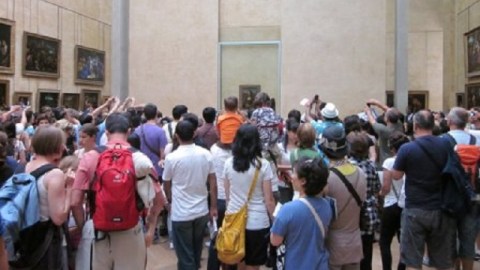Anger Management: Fighting the Crowds at Blockbuster Art Shows

Great art can sometimes be like a magnet—attracting hordes of admirers. The Gauguin: Maker of Myth exhibition that recently closed at the Tate Modern in London, England, drew more than its fair share of fans. According to some patrons, it was far more than a fair share, as complaints that the crowds took away from their enjoyment of the show mount. Is it fair that some people seem to “hog” the art and deny others the lingering look they desire? Or is such box office success the price to pay to see great art in great quantities brought to your locale? How can the anger such blockbuster shows generate be managed?
In retrospect, the Gauguin show seems a perfect storm of outrageous patronage. The first show on Van Gogh’s favorite roommate in England in almost half a century, the accumulated desire to see Gauguin’s work in addition to the great quantity of important paintings, sculptures, etc., made it the “can’t miss” show of the late 2010 and early 2011 season. “It is a magnificent exhibition, but very hard indeed to enjoy,” said one elderly gentleman in the Guardian article. “My wife uses a stick [cane] and she rightly decided not to come in when we heard how crowded it was. She would not have lasted two minutes in there.” Even the fully ambulatory had trouble elbowing past the crowds to spend quality time with the artwork. I did not see the exhibition, but I would guess that the infamous audio tour problem of people absent-mindedly standing in front of a work and listening to the commentary may have contributed to the crowd problems and the resulting frustration. Something about numbered audio tours compels people to follow sequentially, usually resulting in a dense phalanx dominating the sightlines of work after work.
I can understand the frustration. The most underwhelming art experience of my life was coming face to face with the da Vinci’s Mona Lisa at the Louvre. Curators had just moved the “greatest painting of all time” to a new, allegedly more crowd-friendly location. My wife and I stood for 15 minutes in a kind of cattle shoot, slowly edging closer and closer to the tiny masterpiece as the humanity pressed in around us and flashbulbs popped incessantly (similar to the scene shown above). By the time we had slogged to the front for some face time, we had experienced a degree of boxing I’d not seen since Moses Malone retired. The stress of getting to that point robbed the experience of much of the pleasure. We escaped to a nearby hallway and enjoyed much more several other, less famous works by Leonardo in relative freedom.
How do you avoid the mad crush of fandom while allowing access to the masses? In the Guardian piece, British art critic William Feaver suggested “smaller, calmer shows that allow artworks to be enjoyed as intended by the artist,” along the lines of the single-painting shows of smaller museums. I enjoy “smaller, calmer shows,” but, like Feaver, I’m not the typical art patron. Like learning a language, learning about great artists often requires total immersion of the kind only found in blockbusters. By the time you get to the end of a show like Gauguin: Maker of Myth, you should know (or at least begin to know) Gauguin, if you were paying attention. Small shows centered on a single work, even if supplemented with other works or documentation, only whet the appetite. The British public wanted a full-course meal, and came away with indigestion.
So what is the solution? It’s hard to say. The blockbuster art show will be with us for a while, at least on financial and marketing grounds. Americans seem to be more comfortable with blockbuster-sized crowds. I doubt that the Gauguin: Maker of Myth show will cause as much consternation when it comes to the National Gallery of Art in Washington, DC, in February. That different reaction will be a combination of Americans’ greater tolerance for congestion and the simple fact that the crowds in DC will be smaller than at the Tate. British anger arises from the degree to which they sincerely care about experiencing the art. I think Americans, on average, seek more of a tourist experience at blockbusters than an aesthetic one. Looking at it from that angle, the anger left in the wake of the Tate’s Gauguin show is a positive thing—a raging against the dying of the cultural light that burned too briefly for people to see well. Maybe the best way to manage that anger is to channel it into more and more great shows—an embarrassment of riches that will spread out the adoring crowds into a more even and entertained bunch.




